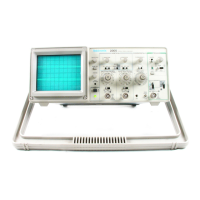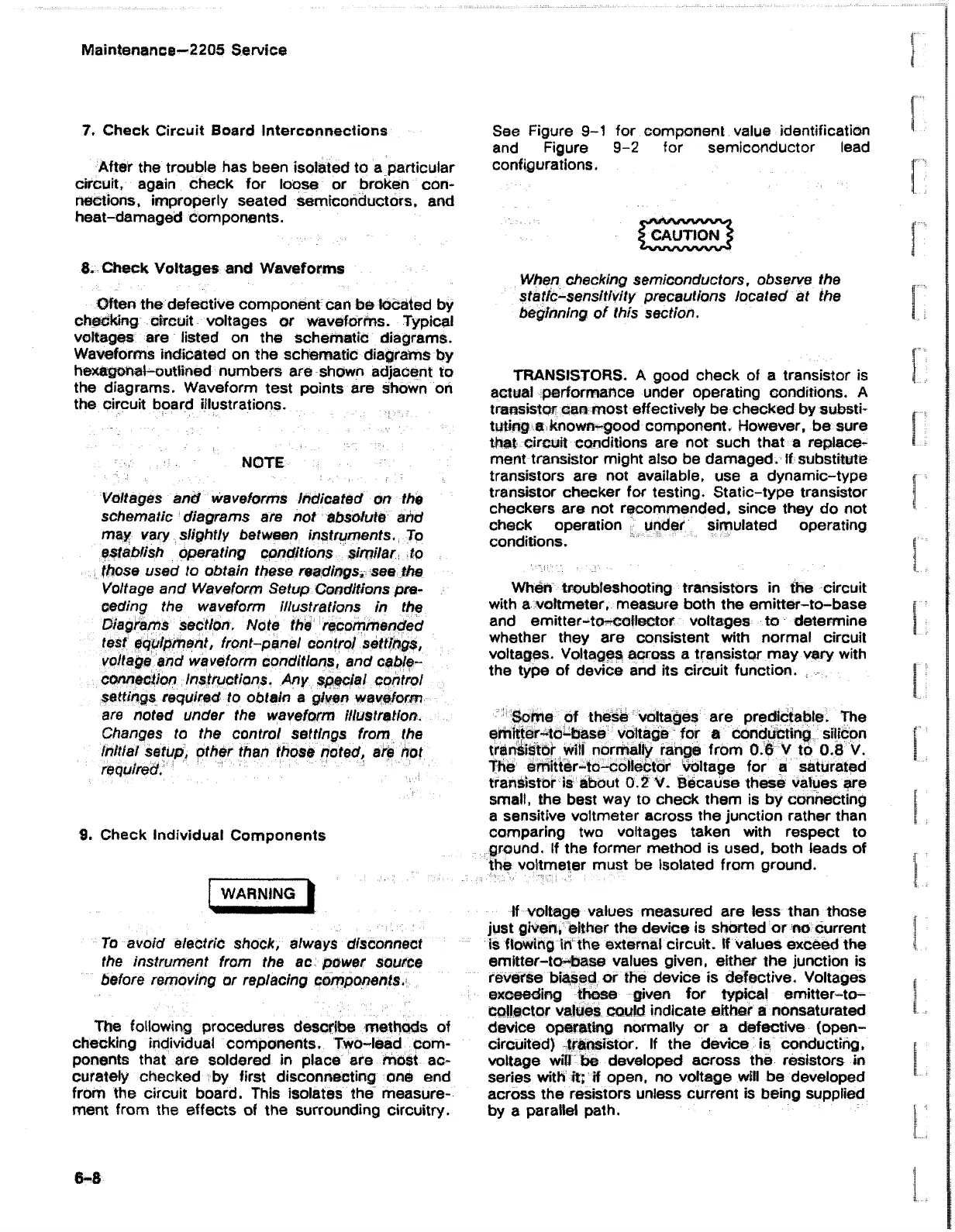Maintenance-2205 Service
7. Check Circuit Board Interconnections
After the trouble has been isolated to a particular
circuit, again check for loose or broken con
nections, improperly seated semiconductors, and
heat-damaged components.
See Figure 9-1 for component value identification
and Figure 9-2 for semiconductor lead
configurations.
i CAUTION
8. Check Voltages and Waveforms
Often the defective component can be located by
checking circuit voltages or waveforms. Typical
voltages are listed on the schematic diagrams.
Waveforms indicated on the schematic diagrams by
hexagonal-outlined numbers are shown adjacent to
the diagrams. Waveform test points are shown on
the circuit board illustrations.
NOTE
Voltages and waveforms Indicated on the
schematic diagrams are not absolute and
may vary slightly between instruments. To
establish operating conditions similar to
those used to obtain these readings, see the
Voltage and Waveform Setup Conditions pre
ceding the waveform illustrations in the
Diagrams section. Note the recommended
test equipment, front-panel control settings,
voltage and waveform conditions, and cable-
connection instructions. Any special control
settings required to obtain a given waveform
are noted under the waveform illustration.
Changes to the control settings from the
initial setup, other than those noted, are not
required.
9. Check Individual Components
^WARNiNGjl
To avoid electric shock, always disconnect
the instrument from the ac power source
before removing or replacing components.
The following procedures describe methods of
checking individual components. Two-lead com
ponents that are soldered in place are most ac
curately checked by first disconnecting one end
from the circuit board. This isolates the measure
ment from the effects of the surrounding circuitry.
When checking semiconductors, observe the
static-sensitivity precautions located at the
beginning of this section.
TRANSISTORS. A good check of a transistor is
actual performance under operating conditions. A
transistor can most effectively be checked by substi
tuting a known-good component. However, be sure
that circuit conditions are not such that a replace
ment transistor might also be damaged. If substitute
transistors are not available, use a dynamic-type
transistor checker for testing. Static-type transistor
checkers are not recommended, since they do not
check operation under simulated operating
conditions.
When troubleshooting transistors in the circuit
with a voltmeter, measure both the emitter-to-base
and emitter-to-colleetor voltages to determine
whether they are consistent with normal circuit
voltages. Voltages across a transistor may vary with
the type of device and its circuit function. ,
Some of these voltages are predictable. The
emitter-to-base voltage for a conducting silicon
transistor will normally range from 0.6 V to 0.8 V.
The emitter-to-collector voltage for a saturated
transistor is about 0.2 V. Because these values are
small, the best way to check them is by connecting
a sensitive voltmeter across the junction rather than
comparing two voltages taken with respect to
ground. If the former method is used, both leads of
the voltmeter must be Isolated from ground.
If voltage values measured are less than those
just given, either the device is shorted or no current
is flowing in the external circuit. If values exceed the
emitter-to-base values given, eithef the junction is
reverse biased or the device is defective. Voltages
exceeding those given for typical emitter-to-
collector values could indicate either a nonsaturated
device operating normally or a defective (open-
circuited) transistor. If the device is conducting,
voltage will be developed across the resistors in
series with it; if open, no voltage will be developed
across the resistors unless current is being supplied
by a parallel path.
6-8

